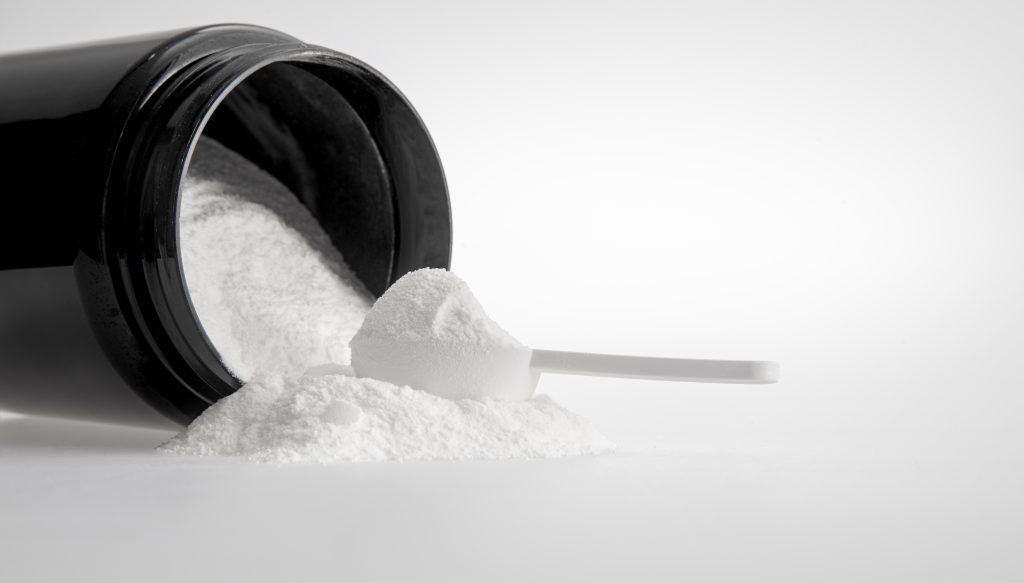Let’s face it:
The supplements industry is not known for its honesty and transparent marketing tactics. Go to any supplements store today, and you’re bound to come across an array of products with shiny labels and solid marketing.
But, whether these products work is a whole other question.
In most cases, products don’t work. Sometimes, they can work but are poorly dosed. And seldom – that thin glimmer of hope – they can be useful and worth the money.
Today, we’ll take an in-depth look at one popular subset of products on the market: pre-workouts. In this guide, we’ll go over what they are, what ingredients seem to work, and much more.
Let’s dive in.
What Are Pre-Workout Supplements (And How Do They Work)?
Pre-workout supplements, as their name suggests, are those that boost our performance and allow us to train harder and achieve better results.
Thanks to good marketing, pre-workouts have become incredibly popular among gym-goers. This has led to the rise of many companies that offer their unique take on what an effective pre-workout supplement should be.
Of course, the effect varies depending on the formula, how each product is dosed, and more. But, the goal is the same: feel more energized, mentally-sharper, and more motivated to train hard.
With that said, you’ve probably noticed a significant issue with pre-workouts:
Apart from a couple of core ingredients, each pre-workout out there seems to have its unique formula with different compounds. So, even if you want to get yourself a pre-workout, you’re more likely to feel overwhelmed and confused about which product to go for.
To help you make more informed choices should you choose to try pre-workout products, we’ve compiled a list of the seven ingredients that offer any benefits. Let’s take a look at what these are.

The Six Ingredients That Make a Pre-Workout Supplement Beneficial
Without further ado, here are the seven ingredients with any scientific backing:
-
Citrulline Malate
Citrulline is an organic amino acid with a hand in numerous bodily processes. When consumed, the body converts citrulline into ornithine and arginine. The two amino acids directly impact our athletic performance.
Specifically, these amino acids play a role in nitric oxide production: a molecule that plays a vasodilation role. It relaxes our blood vessels’ inner muscles, which allows them to widen and improve blood flow (1, 2).
Better blood flow allows more oxygen and nutrients to enter our muscles while toxins and metabolic by-products get escorted out, which prevents them from accumulating.
As a whole, this leads to better pumps and better performance in the gym (3, 4). This could also be the reason why citrulline malate supplementation appears to reduce muscle soreness.
The amino acid is most commonly seen as citrulline malate. To get this ingredient, the amino acid is bound to malate (malic acid), which itself plays a role in energy production.
Since citrulline is only present in watermelon, we must get it as a supplement to reap its benefits.
According to most research out there, we should take six to eight grams of citrulline malate about an hour or so before training. That way, the body has enough time to metabolize it.
-
Beta-Alanine
Beta-alanine is another potential pre-workout ingredient that deserves the title of an ergogenic compound. Similar to citrulline, beta-alanine is also an amino acid and is a building block of carnosine. This is a molecule that aids with acid buffering in our muscles. In other words, it helps keep acidity low, which slows down performance decline (5, 6).
Now, this is where it gets interesting:
Because of beta-alanine’s job within the body, the amino acid appears to boost our physical performance if the activity goes past the minute mark. This is logical because it takes some time for physical activities to cause a rise in acidity, which, in turn, reduces our performance.
In one notable meta-analysis from 2012, researchers looked at fifteen studies with 360 total participants (7). Researchers in the studies gave beta-alanine to 174 of the subjects and a placebo to the remaining 186.
Researchers measured beta-alanine’s ergogenic effects in three exercise ranges: zero to 60 seconds, 60 to 240 seconds, and beyond 240 seconds.
For the zero to 60 seconds, the findings were underwhelming:
For the 14 measures lasting <60 s there was no significant difference between the effect sizes in the BA and Pla groups.
For the 60 to 240 seconds, things were different:
For the 9 measures lasting 60–240 s there was a significant difference between the effect size of the BA and Pla groups.
And for over 240 seconds, beta-alanine’s effects declined gradually:
However, once exercise duration increased over 240 s the beneficial effects of β-alanine supplementation from the 34 measures become less pronounced, although still significant.
In other words, taking beta-alanine appears to be beneficial if the activities you’re doing go beyond 60 seconds and end at or around the three-minute mark. It likely won’t offer much of a benefit for the regular gym trainee because typical gym sets mostly last between 20 and 40 seconds. Still, if your training involves interval running, battle rope, and similar, having beta-alanine in your pre-workout mix could be beneficial.
Unlike citrulline, beta-alanine is not time-dependent – you can take it whenever you wish, and it doesn’t necessarily need to be part of your pre-workout supplement. As far as the dose goes, two to five grams per day seem to be incredibly beneficial. It’s best to start with a low amount, see how it affects you, and slowly increase your intake.
-
Caffeine
Caffeine needs no introduction. As one of the most popular stimulants on the planet, most adults today get caffeine from one source or another.
For example, research suggests that caffeine boosts energy levels and alertness (8). We can also use caffeine to increase our physical strength, explosiveness, and endurance (9, 10, 11). But, if you’re a normal person, you don’t need research to tell you these things.
With that said, you need to be mindful of two things when consuming caffeine: tolerance and its potential effects on sleep. As a stimulant, the body builds up a tolerance to caffeine (12). As a result, caffeine’s effects on the body become less pronounced until we get to a point where it no longer does anything for us. At some point, we might start needing caffeine to feel normal.
To prevent a huge tolerance to caffeine, it is a good idea to cycle it. For example, you can take it regularly for three weeks and then take one full week off. Alternatively, you can cut out caffeine for two days every week.
Another great way to slow down the build-up of caffeine tolerance is to limit your caffeine intake as a whole and only use it strategically before your most demanding workouts.
The second problem to be mindful of is caffeine’s impact on sleep (13). The stimulant has a half-life of about six hours. Meaning, if you ingest 400 mg of caffeine at 4 PM, you will still have about 200 mg circulating your system at 10 PM. Having caffeine in your system can make it more difficult for you to fall asleep. Even if you manage to fall asleep, the quality might worsen, and you might not be able to get enough of the deep and restorative sleep you need.
If you typically train in the evening, it’s best to limit the caffeine intake. If you decide to have it as part of your pre-workout, limit it to no more than 100 mg.
As I’m sure you can agree, the slight potential boost in performance isn’t worth losing sleep over.
As for the caffeine dosage, it will vary from person to person. If you’re not used to taking caffeine, it’s best to start with around 100 mg before training and slowly increase the dose if you find that it no longer works well for you.
-
Beet Root Extract and Betaine Anhydrous
Beets are well known as a healthy food that delivers numerous benefits. Most notably, beets help normalize our blood pressure, provide many nutrients (such as folate and manganese), may promote healthy digestion, and could boost brain health and cognition (14, 15, 16).
The two notable supplements that stem from beets are beetroot extract and betaine. Most supplements typically include betaine anhydrous, but the different forms mostly have the same effects within the body.
Specifically, supplements that come from beets appear to boost our performance, improve body composition, and lead to better pumps. Interestingly enough, betaine has been around for a long time, but it’s only gotten popular in recent years.
The mechanisms behind the actions of beets and beet-derived products are complex. One notable function is the increase in nitric oxide production (17). In a similar fashion to citrulline, our blood vessels can relax, which allows for better blood flow to our muscles (1, 2).
A recent meta-analysis also laid out some explanations as to how betaine impacts muscle gains and fat loss (18). Besides that, we also have some research that shows how betaine can affect our athletic performance (19).
So, while we need more research to understand betaine and beetroot extract, the literature so far is promising, and we should take full advantage. As far as dosing goes, research suggests somewhere between 2,500 and 6,000 mg per day split into two equal doses.
You can find more on betaine in another Pump Some Iron article: “Betaine Benefits for Bodybuilding (More Than a Few Extra Reps)”
-
Taurine
Taurine is an organic acid, and the human body naturally produces it. The substance occurs naturally in several foods, most notably in meats. According to research, large doses can deliver numerous fitness and health-related benefits.
Contrary to what some people believe, taurine is not… bull urine. This is one of those rumors with an unknown source, but it holds no truth. Taurine’s name stems from the fact that the substance was first isolated from bull bile.
Specifically, taurine appears to boost our exercise performance, decrease muscle soreness, and can even pose mild testosterone-boosting benefits.
Research shows that taurine helps remove waste from our muscles, which prevents the build-up of metabolic by-products (20, 21). This can help prolong time to exhaustion and allow us to do more work in the gym. As we know, training volume is tightly correlated with muscle gain (22).
Studies have also found that taurine supplementation reduces physical stress markers and leads to decreased muscle soreness (23). In one interesting study from 2010, researchers found that taurine can help us burn slightly more fat (24). Cyclists took 1.66 grams of taurine or a placebo. Those that took taurine experienced a sixteen percent improvement in fat oxidation rates.
According to research, we should ingest between 500 and 2,000 mg, though higher doses are also well-tolerated.
-
L-Tyrosine
Though not as popular as some of the other ingredients on our list, l-tyrosine is worthy of recognition. This organic amino acid can boost our energy, lift our mood, make us more alert, and increase our focus (25, 26). All of these attributes are beneficial when trying to make the most of our workouts.
Unlike caffeine, l-tyrosine is not a stimulant, and the body doesn’t develop a tolerance for it. It also doesn’t appear to impact our sleep as much, making it an excellent option for a pre-workout if you tend to train in the evening.
L-tyrosine is used to produce the hormone noradrenaline and the neurotransmitter dopamine. Besides that, l-tyrosine shows promise as a protective agent against acute stressors, such as having a training session. How the amino acid manages to pull this off is rather interesting:
As we expose the body to an acute stressor, catecholamine depletion accelerates. This means that the body uses noradrenaline at a faster rate. Once it uses it up, fatigue sets in, and we cannot carry out what we are doing at the same rate.
While overall catecholamine production in the body occurs under strict control, some research suggests that having more l-tyrosine available in the body can boost noradrenaline synthesis during stressful situations. In turn, this makes us more resilient to stress – both physical and psychological.
As far as the dose goes, 500 to 2,000 mg taken an hour or so before working out seems to deliver the benefits. Some research shows that tyrosine appears to be incredibly beneficial when taken at a dose of 100 to 150 mg per kilogram of body weight. For example, if you weigh 80 kilograms (176 lbs.), that would be a dose between 8,000 and 12,000 mg.
Still, it’s best to start with a low dose and see how it affects you. There is no need to jump the gun immediately.

The Problem With Most Products On The Market Today
As consumers, we face a huge problem with most supplements on the market: they suck. This might be a bit blunt, but it’s the truth. Most products on the market exist to make money. Helping the consumer is an afterthought for manufacturers.
One common problem – and a reason why supplement companies get away with it – is the proprietary blend. The proprietary blend is a term that refers to how a nutritional label can get structured. Specifically, manufacturers are required by law to list all of the ingredients present in their products. But, should they choose to, they can hide the ingredient amounts behind a proprietary blend. That frees them up from disclosing how much of each ingredient you’re getting.
For example, a supplements manufacturer might list citrulline malate and beta-alanine on their label. But if both ingredients are under a proprietary blend, you won’t know how much you’re getting. As you can imagine, this is a huge problem.
As we discussed above, for citrulline malate to be effective, you need to take a dose of six to eight grams. If you don’t take enough, it won’t have a beneficial effect.
But why does this proprietary blend even exist? Well, the thinking goes, if a company comes up with a fantastic recipe for a product (a pre-workout, for example), they don’t want competitors to copy their hard work and create a competitive product at half the cost. But come now:
Those guys aren’t making Coca-Cola. They are mixing a few well-known ingredients. What’s more, we have tons of research out there that points at how much of an ingredient we need to feel its effect.
Hiding that critical information from the consumer prevents them from making an informed choice. Even worse, some sleazy marketers use the proprietary blend to create and sell crappy products. For example, they might include trace amounts of citrulline malate, list it on the label, and hide the actual amount. People who don’t know any better would buy it without thinking.
So, you must read through the nutritional label carefully. If you spot a proprietary blend, it’s best to approach it with skepticism and move to another, more transparent company.
Typically, when buying supplements, it’s best to go for products that list everything on the label and have a stamp of approval from a third-party testing company. These companies help consumers make more informed decisions by examining different products and proving or disproving the label’s information. If a given product meets their quality criteria, they get labeled, and we, as consumers, know that the product is worth buying.
One such testing company is USP. You can read more about their verified mark here.
So, Are Pre-Workouts Worth It?
Well, it depends. As we saw above, several ingredients have extensive research behind them and are proven to have ergogenic effects. So, it’s logical that we take them if we want to optimize our gym performance.
The sad thing is, many pre-workouts on the market can’t work the way we want them to. As we saw above, for citrulline malate to benefit us, we would have to take a dose of six to eight grams. Add another three grams of beta-alanine, three grams of betaine, a gram of taurine, and a gram of tyrosine, and you’ve got yourself a hefty scoop. Most pre-workouts on the market are barely three to five grams per serving. As you can imagine, this can’t possibly be enough to include the effective ingredients in a large enough dose.
Another common issue with many pre-workouts today is that they include a lot of caffeine. This is logical because caffeine boosts our performance and is cheap to acquire. So, it seems like a win-win. The problem is, some people might not want caffeine in their pre-workout. If you train in the evening and take your pre-workout around, say, 5:30 PM, that caffeine might later disrupt your sleep.
So, an alternative here is to make your pre-workout supplement with the ingredients you want and need. You can buy the components separately, mix them, and know precisely what you’re taking.
With that said, I do have one caveat:
It’s best to avoid buying raw caffeine because it is a potent stimulant. If you accidentally take too much, it can pose serious health risks. Instead, get the other ingredients and get some caffeine from safe sources like coffee and energy drinks.
The Bottom Line
Pre-workouts are undoubtedly one of the most popular fitness supplements on the market. With the ever-growing demand, we also see bigger and more fierce competitors fighting for market share.
These days, countless companies and influences have their unique take on what a pre-workout should be, and the result is obvious:
Consumers are overwhelmed, frustrated, and confused. As a normal trainee who wants a simple and effective formula, finding one in the literal sea of options can be an incredibly challenging task.
My suggestion is to read the list of ingredients carefully and choose an option that meets the criteria above. Either that, or buy all the ingredients separately and make your own.
Now, pre-workout or not, It’s time to go Pump Some Iron!


